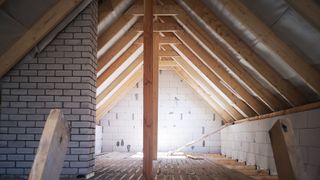Is My Loft Suitable for Conversion?
If you find yourself asking if your loft is suitable for conversion then make sure you put your mind at rest and consider these key factors before calling in the builders

Wondering if your loft is suitable for conversion? It's an important question and although the answer is often yes, and the vast majority of houses are ideal for converting upwards, there are issues that can potentially affect some properties’ suitability.
From the building's foundations to fire safety regulations and where to situate the stairs, there is a lot to consider before spending any time or money.
Here's what to consider before embarking on yourloft conversionproject.
1. Am I Going to Need Planning Permission?
The majority of loft conversions are successfully carried out underPermitted Development(PD) without the need for a formal planning application.
A typical PD-compliant design might have discreet rooflights fitted flush to the front roof slope with a large projecting dormer window added to the rear. This type of design effectively maintains the property’s appearance from the street, so it looks virtually unchanged.

Whilst there’s no guarantee of success with planning applications, it can improve your chances if you can demonstrate that similar conversions have been permitted recently on other homes in the local area.
For conversions with more prominent roof extensions, such aship-to-gable loft conversionsor dormers added to the front or side elevations, you will need to apply forplanning permission.
Planning consent will also be required for loft conversions to listed buildings, properties located in Conservation Areas, and in cases where PD Rights have been removed by the council.
(MORE:23 Things You Can Do Without Planning Permission)
2. Is My Loft Big Enough?
To be suitable for conversion to living accommodation, it helps if you’ve got a sizeable roof space to start with.
A simple way to calculate this is by measuring the gross internal floor area of all the existing top floor rooms under the loft you want to convert.
Most lofts can provide at least 20m2 of gross floor area which, on paper, should be more than enough for a double bedroom. However, not all of this space will be useable. A lot depends on the roof pitch – as a rule, the steeper the better.
The net amount of usable floor area for new loft room(s) can be calculated by deducting the space lost around the edges near the eaves where height is less than about 1.2m, and then making an allowance for the new loft stairwell, plus obstacles like chimney breasts.
3. Can I Convert My Loft if it Doesn’t Have Much Headroom?

The main ‘pinch-point’ with loft conversions can be summed up in a single word - headroom.
是否你的阁楼的品位,简单的年代tand under the highest point of the roof, usually in the centre of the loft, and check whether there is at least 2.8m clear vertical space.
This may sound overly ambitious, but the available space will shrink once the new floor structure is constructed and the rafters are lined with thick layers of insulation.
If your loft passes this test, you’re off to a flying start. Even if the amount of full height headroom is largely restricted to the centre part of the loft, it’s usually possible to add a large box dormer to dramatically extend the usable floor area.
Where there is insufficient headroom in a loft, things get a bit trickier.
However, there are still possible solutions:
- First, there’s nothing to stop you from applying for planning permission to substantially enlarge the roof by raising its height. However, the chances of success are generally not great, particularly in semi-detached and terraced houses (even with the benefit of recently relaxed PD rights)
- An experienced designer should be able to come up with a design that minimises visual impact, hopefully making it more acceptable to the planners (such as a dual pitched mansard roof)
- A more pragmatic solution that has the advantage of retaining the existing roof profile is simply to borrow some ‘spare’ headroom from the rooms directly below. Here the existing bedroom ceilings are taken out and rebuilt at a lower level as part of the new loft floor structure.
But for this to work, you need generous existing ceiling heights.
(MORE:Loft Conversions for Difficult Roof Constructions)
4. Where Will the Loft Stairs Go?
The next big test of suitability is how the loft stairs can be made to fit within the confines of the home.
If it turns out that you need to sacrifice an existing bedroom to accommodate the new staircase it might not make sense to proceed, particularly if you’re only gaining one relatively small new bedroom in the loft.
The most ergonomically efficient place to locate new loft stairs is normally above the existing flight. If they can be designed to surface at the perimeter of the new loft room, it should help maximise available living space.
Unfortunately, this location often clashes with a roof slope, in which case the solution may be to construct a new dormer directly above to provide the necessary headroom.

Moving the stairs to a more central position can sometimes work, but you normally want to avoid them ascending plum in the middle of new loft accommodation and spoiling the desired layout.
Bear in mind that loft stairs typically need to be constructed with a small enclosed fire-lobby either at the top or bottom, so this will need to be taken into account when designing the living space.
5. Ensure Your Loft Can Comply With Fire Regulations
One of the most challenging aspects of any loft conversion project is compliance withfire regulations. The bar is raised a lot higher for multi-storey houses.
Where you’ve got more than two existing floors, adding extra living space in the loft can involve quite draconian measures, such as constructing external escape stairs or installing complex sprinkler systems.
Conventional two-storey houses are generally more straightforward to convert, primarily requiring an ‘escape corridor’ leading down to the main entrance door.
The main challenge here is in properties with open-plan ground floors, which are likely to need partitioning to create a new fire-resistant entrance and hallway.
6. Can I Convert My Loft if My House is Old?
Some types of property are more challenging to convert than others. For example, detached houses have certain advantages, such as not worrying about party walls and generally benefiting from larger lofts.
In terms of roof structures, modern trussed rafters (post circa 1970) are more complex to convert than older traditional ‘cut timber’ roof structures, but this is no longer regarded as a major obstacle.
Older period properties are generally less robust and may not take kindly to the addition of substantial new loadings and major structural alterations without expensive upgrading.
(MORE:The Party Wall Act)
7. Is a Loft Conversion Worth the Expense?

Onlineloft conversion costcalculators claim to be able to provide ball-park figures for loft conversions based on the floor area of your loft - defined as small (25m2), medium (40m2) and large (55m2+).
But estimated costings of this type can be rather hit and miss because they ignore other important factors. For example, if you want to add another floor to a three-storey or higher house, costs will escalate due to extra work complying with fire regulations and the need for more extensive scaffolding.
But perhaps the biggest unexpected cost that’s likely to arise in older buildings is where thebuilding foundationsare not sufficiently robust to support the new loadings.
This will require a structural engineer to design a suitable new framework, such as steel columns supported on pad foundations. Costs start to escalate where an existing roof is on its last legs.
Although it can make financial sense to make use of the loft conversion scaffolding, recladding the roof could add anything from about £4k to £12k to the project’s bottom line.
(MORE:典型的阁楼转换计划)
Get the Homebuilding & Renovating Newsletter
Bring your dream home to life with expert advice, how-to guides and design inspiration, direct to your inbox.
Chartered surveyor Ian Rock MRICS is a director isRightsurvey.co.ukand the author of eight popular Haynes House Manuals, including theHome Extension Manual,Self Build ManualandPeriod Property Manual.
Ian is also the founder of Zennor Consultants. In addition to providing house surveys, Zennor Consultants provide professional guidance on property refurbishment and maintenance as well as advising on the design and construction of home extensions and loft conversions, including planning and Building Regulations compliance.
Ian has recently added a 100m2 extension to his home; he designed and project managed the build and completed much of the interior fit-out on a DIY basis.
Most Popular
Bring your dream home to life with expert advice, how-to guides and design inspiration, direct to your inbox.
Thank you for signing up to Homebuilding. You will receive a verification email shortly.
There was a problem. Please refresh the page and try again.

